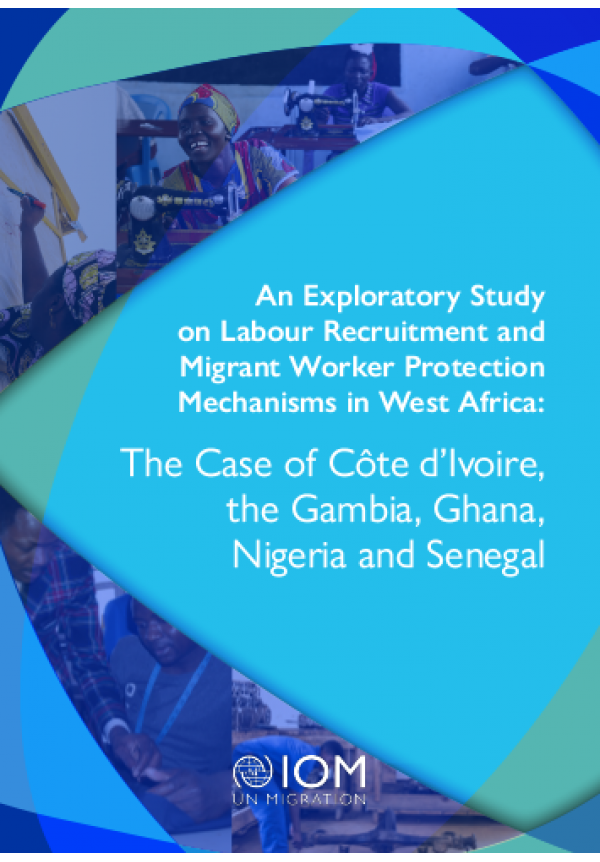
An Exploratory Study on Labour Recruitment and Migrant Worker Protection Mechanisms in West Africa: The Case of Côte d'Ivoire, the Gambia, Ghana, Nigeria and Senegal
The topics of ethical recruitment, defined as the recruitment of workers in a lawful, fair and transparent manner that respects their dignity and human rights, and labour migration, defined as the movement of persons from one State to another, or within their own country of residence, for the purpose of employment, go hand in hand. While labour migration can serve as a significant opportunity, it can also constitute a risk for those who partake in it. A risk may present itself if labour migration is undertaken as an end result of unethical recruitment practices, which may include practices that are non-transparent and fail to respect the dignity as well as human rights of workers. In such circumstances, workers may be at risk of exploitation during both the recruitment process and employment. Consistent adherence to ethical recruitment practices by all parties implicated in the recruitment process (including private recruitment agencies, employers and jobseekers) therefore significantly contributes to the reduction of these risks.
In West Africa, this correlation is particularly relevant as young West African migrants attracted by false promises of employment, high wages and decent working and living conditions are increasingly subjected to exploitative recruitment processes. Through this study, IOM seeks to shed light on this situation by assessing current recruitment practices and migrant worker protection mechanisms in place in the following case study countries: Côte d’Ivoire, the Gambia, Ghana, Nigeria and Senegal. This study explores and critically examines the existing evidence base on key aspects of the topic to inform potential policy and programmatic responses designed to enhance labour migration impacts for current and potential migrant workers located in as well as originating from West Africa. This publication entails both a desk-based review of the current published evidence base as well as insights derived from interviews with national stakeholders from the five case study countries.
This research publication was made possible through support provided by the Migration Resource Allocation Committee (MIRAC).
Read More
- List of Abbreviations/acronyms
- Definition of Key Terms
- 1. Rationale for the Study
- 1.1. Objectives of the Exploratory Study
- 1.2. Methodology
- 1.3. Limitations
- 2. Case study analysis
- 2.1. Côte d’ivoire
- 2.1.1. Situational Analysis
- 2.1.2. Labour Migration Management at the National Level
- 2.1.3. Non-State Actors and Labour Migration
- 2.1.4. Main Barriers to Ethical Labour Recruitment and Migrant Worker Protection and Recommendations
- 2.2. The Gambia
- 2.2.1. Situational Analysis
- 2.2.2. Labour Migration Management at the National Level
- 2.2.3. Non-State Actors and Labour Migration
- 2.2.4. Main Barriers to Ethical Labour Recruitment and Migrant Worker Protection and Recommendations
- 2.3. Ghana
- 2.3.1. Situational Analysis
- 2.3.2. Labour Migration Management at the National Level
- 2.3.3. Non-State Actors and Labour Migration
- 2.3.4. Main Barriers to Ethical Labour Recruitment and Migrant Worker Protection and Recommendations
- 2.4. Nigeria
- 2.4.1. Situational Analysis
- 2.4.2. Labour Migration Management at the National Level
- 2.4.3. Non-State Actors and Labour Migration
- 2.4.4. Main Barriers to Ethical Labour Recruitment and Migrant Worker Protection and Recommendations
- 2.5. Senegal
- 2.5.1. Situational Analysis
- 2.5.2. Labour Migration Management at the National Level
- 2.5.3. Non-State Actors and Labour Migration
- 2.5.4. Main Barriers to Ethical Labour Recruitment and Migrant Worker Protection and Recommendations
- 2.1. Côte d’ivoire
- 3. Conclusions
- References